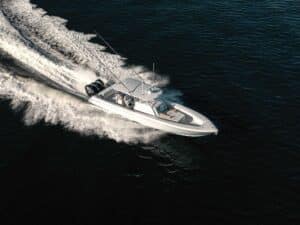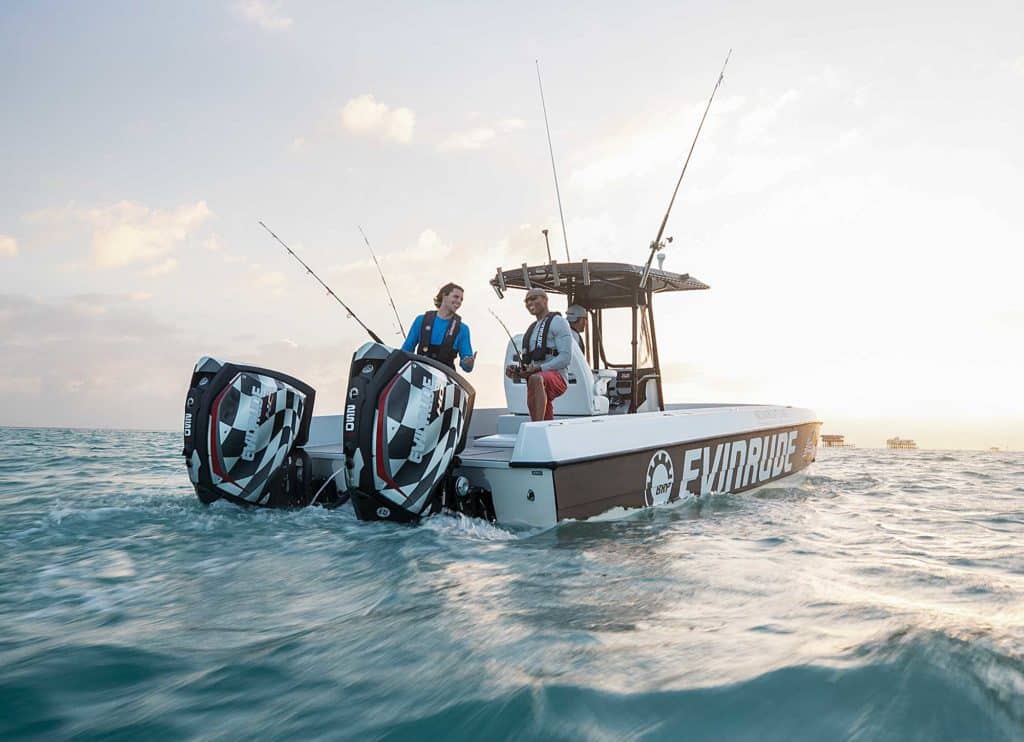
Escape the surly bonds of Earth, to paraphrase a pilot’s ditty — it’s pretty much the call of the sea for offshore anglers too. Pushing out to sea, leaving behind ramps and docks and traffic noise and congestion — you see the earth as Columbus saw it — and on a good day you bloody the deck. The ideal offshore fishing boat varies in hull styles, but there are trends to what most anglers want their offshore fisher to provide them with. Fifty-three percent plan to buy center-consoles. Seating needs to accommodate a crew of four, according 64 percent of our respondents. On deck, five to 10 rods are in their arsenal, and 67 percent need holders for them on the gunwales. Fifty-nine percent want dry storage for up to 12 of them while on the run. While some boatbuilders are creating a necklass of rod holders around the deck, 42 percent are happy with six gunwale rod holders for fishing. If their boat had only four, though, 13.2 percent would spend up to $400 to add two more. To keep the rods rigged, 51 percent wanted handy storage for at least four utility boxes in the rigging area of the cockpit.
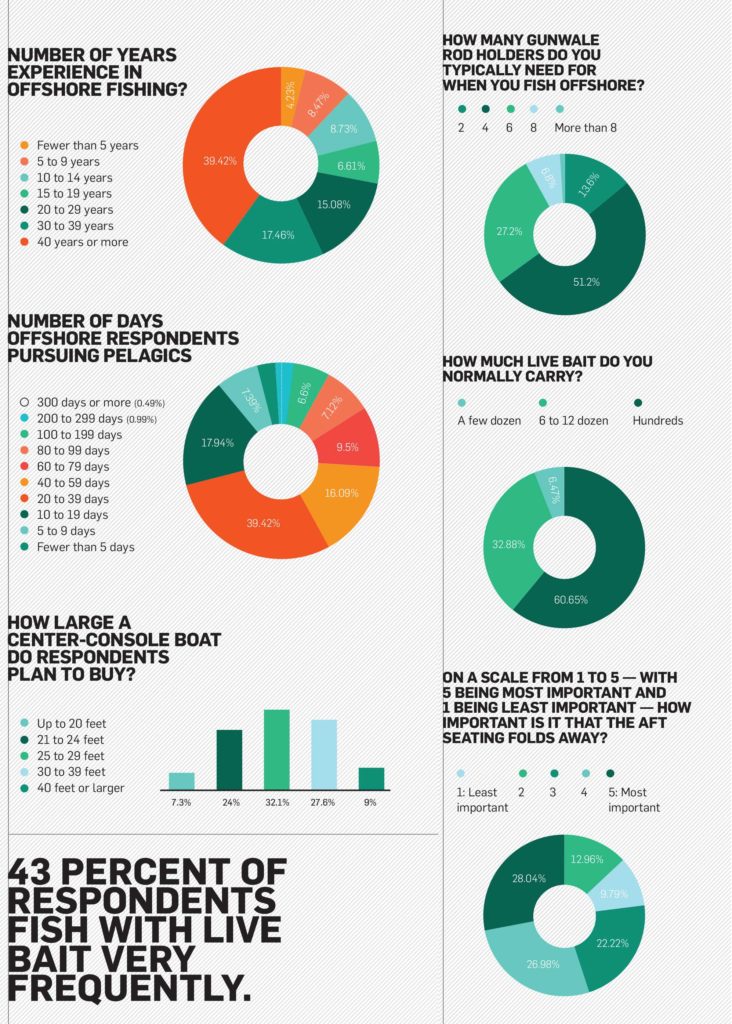
Twenty-nine percent want handy deck storage for six utility tackle boxes. If you fish offshore, 43 percent of you fish with live bait quite frequently and expect livewells to cover their action. One livewell seemed adequate for 57 percent of our respondents, but the rest wanted two or three. A good number of our respondents expected livewells to keep dozens of baits and many larger fish such as blue runners alive all day long.
Offshore fishing means different things to different anglers. We were shocked to hear that 8 percent of our respondents didn’t care if they caught a fish at all. That’s just weird.
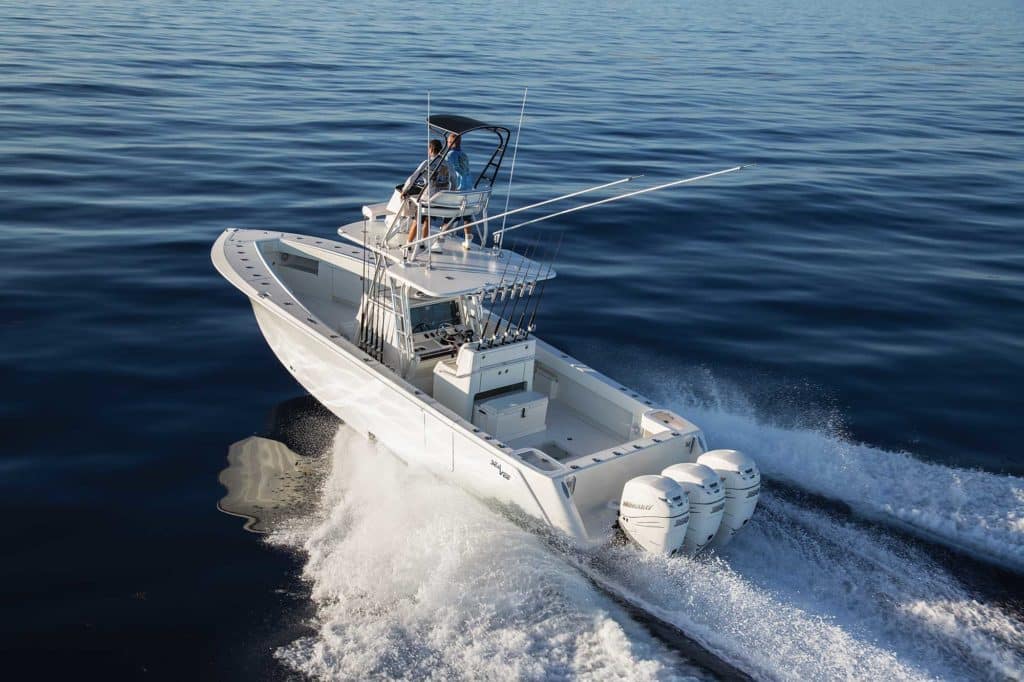
Center Consoles
By Jim Hendricks
Few boat types have grown more in size, horsepower and popularity than offshore-style, outboard-powered center-console fishing boats over the past decade. A large part of this is due to the great popularity of offshore fishing. Among respondents to our survey, 63 percent have been offshore fishing in the past 12 months, and 24 percent own offshore-style center-consoles. Fifty-three percent would make their next boat an offshore center-console.
The addition of family-friendly amenities such as bow lounges and comfortable, cabinlike console interiors has helped spur the surge in popularity, but so have ongoing improvements in the fishability of today’s center-console, including 1) faster, softer-riding more-efficient hulls; 2) advancements in outboard propulsion systems; 3) more bait-kindly livewell capacity; and 4) expansion of rod stowage.
While there are many features to consider, our survey tells us that these four rank as critical factors for boating anglers shopping for a new center-console. Let’s take a closer look at each.
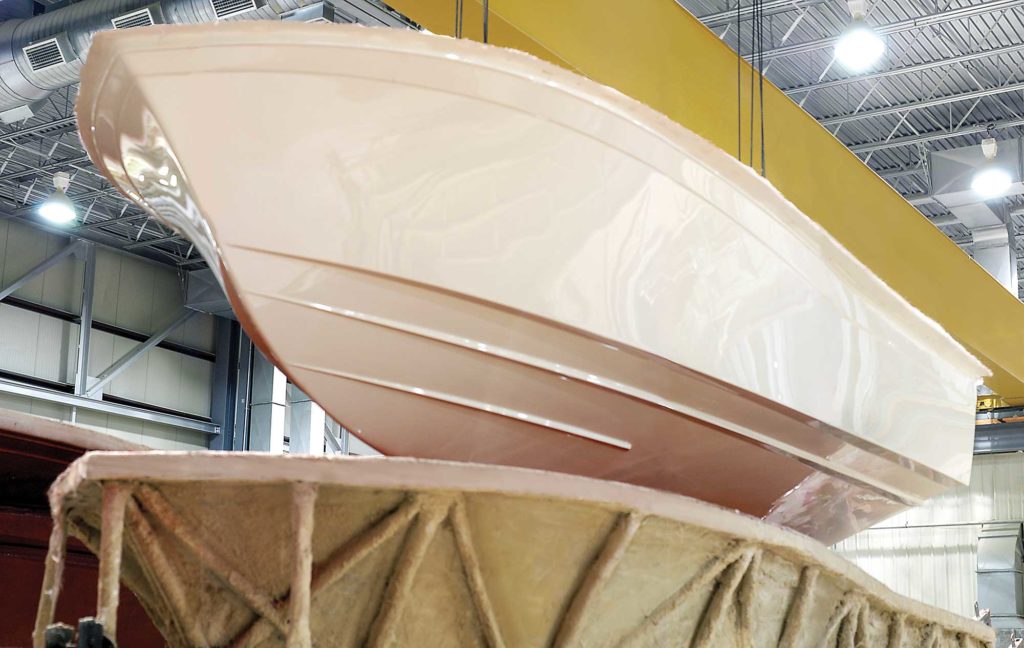
Hulls
Advancements in hull design over the past few years translate to lighter, faster, smoother-riding and more-efficient center-console fishing boats. Sophisticated new construction methods reduce weight as well.
Refinement of the efficient step hull stands out as one of the most significant developments, but many offshore center-console boats still effectively employ conventional deep-V hull designs. Grady-White’s state-of-the-art SeaV2 variable-deadrise hull is a notable example.
Neither hull type is necessarily better than the other, but they are distinctive. “Bow rise during hole shot is an inherent characteristic of a deep-V hull,” says John Caballero, sales and marketing director for Miami-based SeaVee Boats, which offers both deep-V and step hulls.
Most step hulls, on the other hand, use two steps to separate the running surface into three parts: bow, midsection and stern. This, in turn, divides the large pressure wave into a trio of smaller ridges, one under each part of the hull, to virtually eliminate bow rise during hole shot.
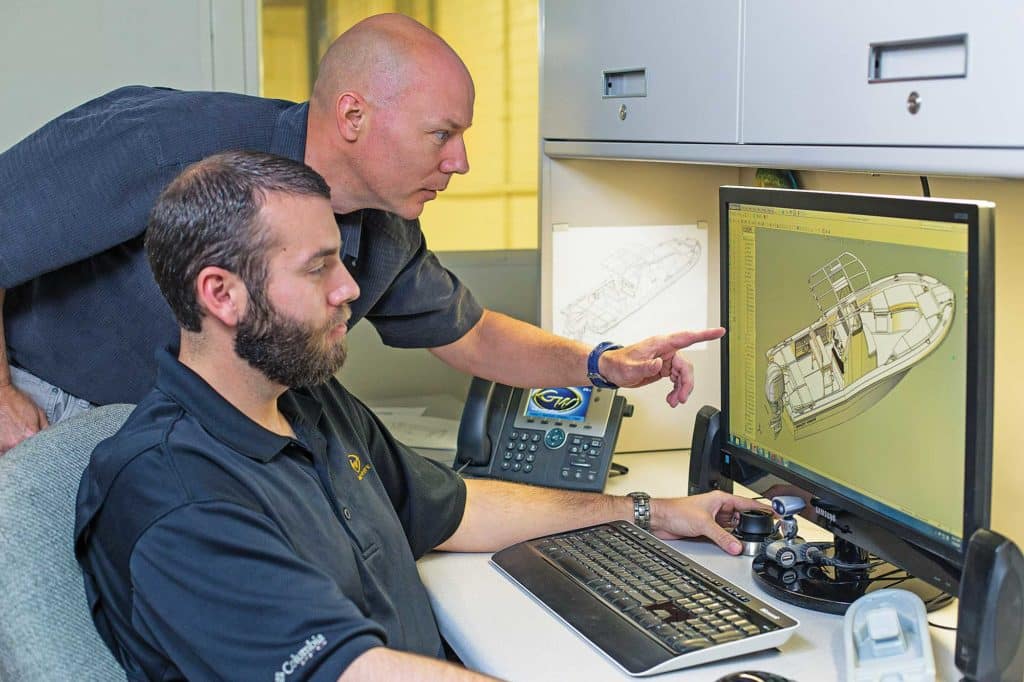
“With the ridges providing lift at three points along the length of the boat, well-designed step hulls rise almost evenly out of the hole,” Caballero says. What’s more, the running attitude remains inherently fixed while underway, with the bow at about a 4-degree up angle — and little need to play with engine trim or tabs.
The recesses of the steps also create a slight vacuum while underway. This draws in air from the sides, then ushers a film of aeration between the hull and water to break up surface tension, reducing friction, making the boat more slippery and easier to glide over the water. That increases speed over the throttle range and improves fuel efficiency. While speed wasn’t an important factor to survey respondents, fuel efficiency and range were characteristics important to our respondents.
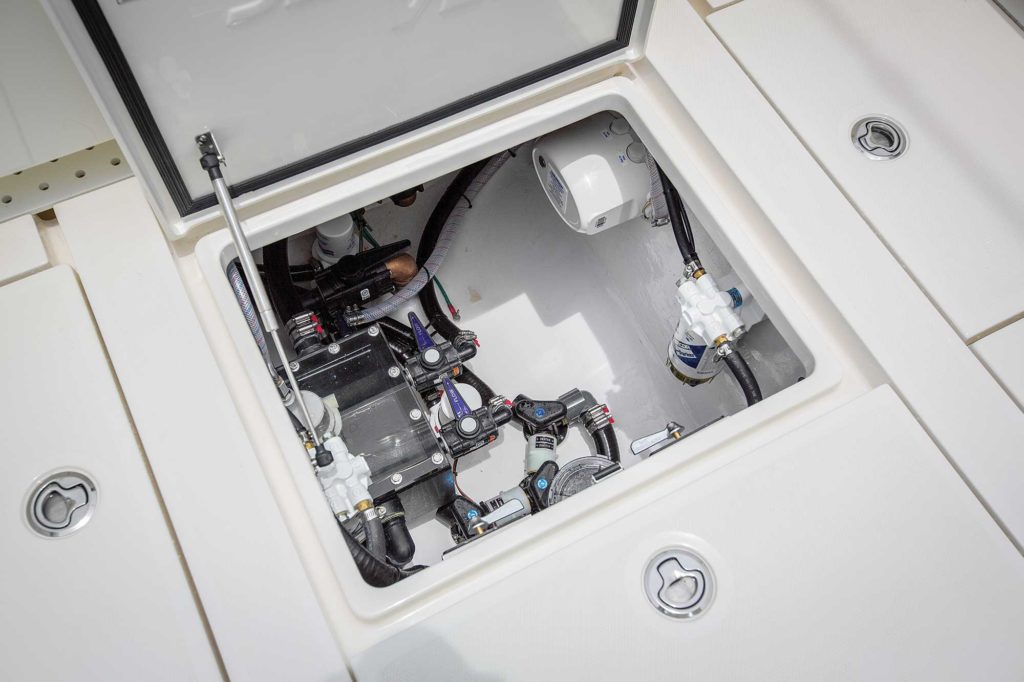
Advanced construction materials have led to lighter hulls, enabling greater fuel efficiency and range, says Wylie Nagler, owner and president of Yellowfin Yachts. “Our Carbon Elite option uses carbon-fiber construction to create a 20 percent weight savings versus fiberglass construction,” Nagler says. This translates to a 10 to 12 percent increase in speed, fuel efficiency and range, Nagler reveals. At the same time, he says, carbon-fiber material costs four to five times as much as fiberglass material, which affects prices.
New-age construction techniques have led to the creation of ever-larger center-console models. HCB’s new Estrella 65, for example, utilizes a building technique known as Comsys, which was previously employed for building high-performance military vessels. Mike Yobes, HCB’s vice president of marketing, explains: “Comsys uses foam stringers placed strategically in the hull, then fiberglassed in place, then the voids are foam-filled, giving a solid hull, light and efficient, but able to combat rough seas. To add strength, we use Kevlar to reinforce the keel.”
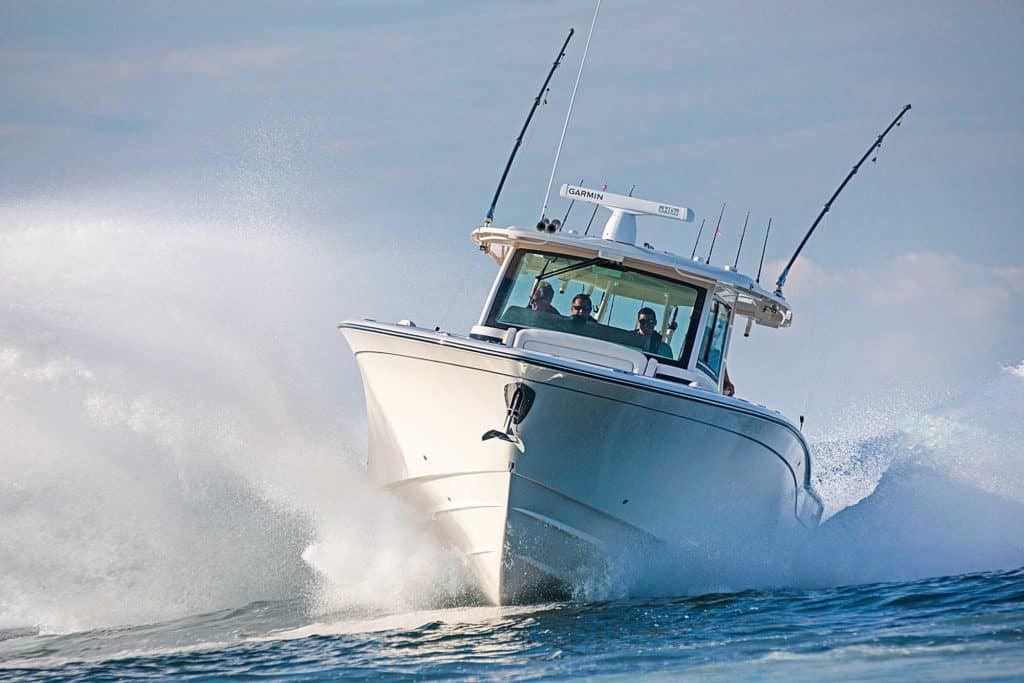
Power
Outboard motors have propelled center-consoles since the inception of this boat type 58 years ago. Since then, outboards from brands such as Evinrude, Honda, Mercury, Suzuki and Yamaha have progressed mightily. Today, horsepower of a single motor ranges upward to 627 ponies. Reliability and performance of all brands have grown, as have ease of operation, corrosion resistance and fuel efficiency. Little wonder, then, that they are such a great match for center-console fishing machines.
Whether ordering a production model or speccing out a custom-ordered center-console, you will want the boat rigged with power by the factory, says Ry Landry, product manager for Yamaha, which offers outboards up to 425 hp in its XTO V-8. “This offers assurance that the power system operates seamlessly and provides the best experience for the boat owner,” Landry explains. “It also means that the choice of propellers, engine height on the transom, and other rigging details will already be dialed in when it’s delivered.”
No matter what the brand, it is best to choose the maximum-rated horsepower, Landry says. “You might not always use all that horsepower,” he says, explaining that you don’t need to constantly pin the throttles. “But it is good have that extra power available when you need it.”
What’s more, fuel efficiency is often better when running a bigger motor at a midrange throttle setting than running a smaller motor at a higher rpm. Also, boats tend to gain weight as they age, a consequence of adding accessories and gear. Having the max horsepower helps ensure you will always enjoy sufficient midrange torque.
Having the maximum power can also bolster the resale value of a boat, especially as engines are introduced in subsequent years with greater horsepower. The less horsepower you have, the less desirable your boat becomes in the resale environment.
Boat buyers need to consider the entire system — not just the engines — when specifying outboard power. Joystick low-speed steering, for example, is becoming more of an expectation than an option, says Lee Gordon, director of global communications for Mercury Marine, which offers outboards up to 400 hp in the Verado 400R.
“Mercury’s Joystick Piloting for Outboards gives consumers more confidence when maneuvering their boats in slow-speed situations, such as docking,” Gordon says. Added features such as Skyhook, Auto-Heading and Route Tracking also make fishing easier. With Skyhook, for instance, you can anchor a boat over a wreck without actually using an anchor.
Electronic throttles, power steering, digital displays and networking capabilities render outboards easier to use than ever before, and these features are often bundled with the motor. For example, Evinrude’s E-TEC G2 outboards, which range upward to 300 hp, include electronic throttle and shift and power steering. New systems, such as Evinrude’s iTrim and Mercury’s Active Trim, can trim a boat automatically. And now multi-function engine displays, like Evinrude’s ICON or Mercury’s VesselView, eliminate the need for multiple analog gauges. Even better, engines can be networked with onboard multifunction screens, giving more functional display options.
Livewells
The ability to keep bait alive and healthy in livewells ranks as one of the top considerations among our survey respondents when it comes to selecting a new fishing boat. Forty percent use live bait when pursuing offshore species, and 45 percent use live bait for bottomfish. From ballyhoo, blue runners, goggle-eyes and mackerel, to pilchards, sardines, speedos and threadfins, live bait is an important element aboard an offshore-style center-console fishing boat.
You need to pamper your bait and keep it from bloodying its nose on hard surfaces. To minimize inherent sloshing that jostles bait, a livewell should be taller than it is wide. A rounded column shape also promotes “milling” — the tendency of the bait to swim in a relaxed circle. Oval works well too.
Pressurizing the livewell also minimizes sloshing. This requires a pump and plumbing that slightly overfills the well, and a compression hatch latched to keep water from spilling onto the deck. A clear hatch lets you to check the bait without opening the top.
More-advanced livewells have the side drain at the top, plumbed overboard on the outside of the tank. It works better than a standpipe and eliminates a place for bait to hide.
Transom livewells are easy to access while fishing in the stern; some center-consoles have one, others have two in this area. Another common and efficient location for livewells is behind the leaning post. Both take advantage of the softer-riding part of the boat. A well under the aft deck is a common option, allowing you to dramatically increase bait capacity and making an easy place to purse the net.
For livewells ranging from 20 to 32 gallons, look for a fill time of six to eight minutes, while tanks ranging 33 to 50 gallons should fill in eight to 12 minutes. Fresh water should enter from the upper portion of the tank to avoid stirring sediment shed by the bait.
The most advanced livewell systems use pump boxes to eliminate aeration, which can kill bait. Eliminating aeration is especially critical with step hulls that naturally introduce air under the hull. Pump boxes immerse bilge pumps in seawater and bleed off air through a vent at the top of the box so the pump can deliver aeration-free water to livewells.
Lights in the tank may help bait more safely mill about, but they definitely help anglers net bait with a minimum of disturbance. A clear livewell lid keeps bait calm and eliminates the rush to the bottom of the tank when an opaque lid is opened.
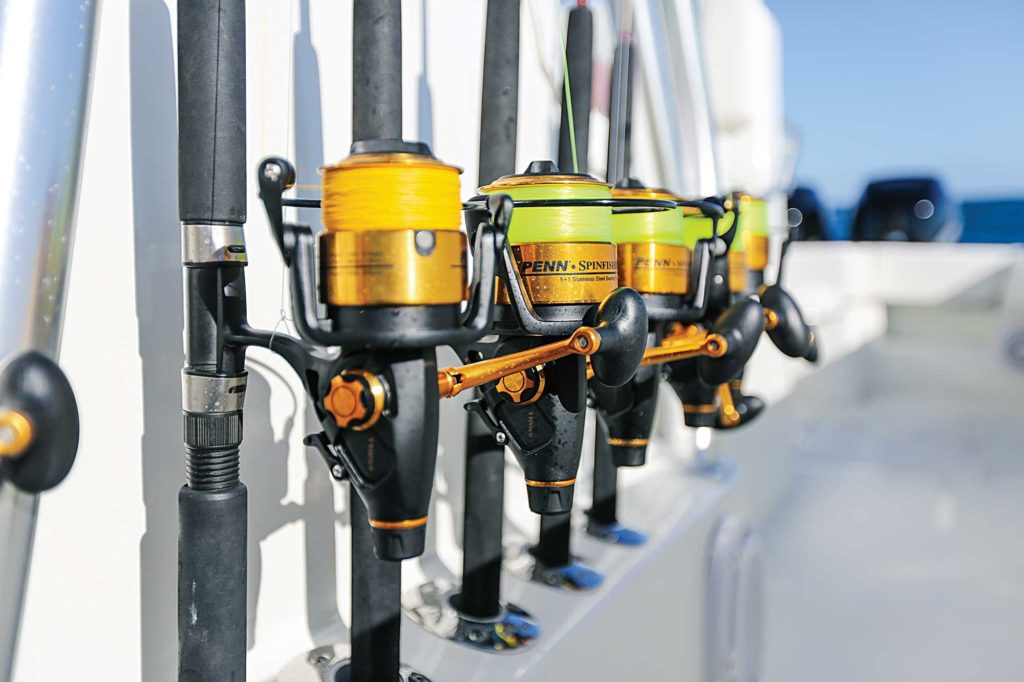
Rod Stowage
Having a sufficient number of rod holders stands as a key factor when buying a boat.
Rod capacity is particularly critical on a center-console designed for bluewater fishing, and 62 percent of the respondents in our survey carry up to 11 rods, and 19 percent carry 11 or more.
“Offshore fishing is more tackle and equipment intensive, and the gear tends to be larger than that for inshore fishing,” says Charlie Johnson, director of marketing for Maverick Boat Group, which includes the Cobia brand. “Offshore rods and reels are often bigger, and you usually carry more in anticipation of a variety of opportunities, like seeing a school of dolphin (mahi) while you’re wreck-fishing,” Johnson explains.
Gunwale rod holders need to be reserved for trolling, not stowage. Rods in gunwale rod holders are subject to drenching, corrosion-inducing spray while underway, which is considered dé classé in some angling circles.
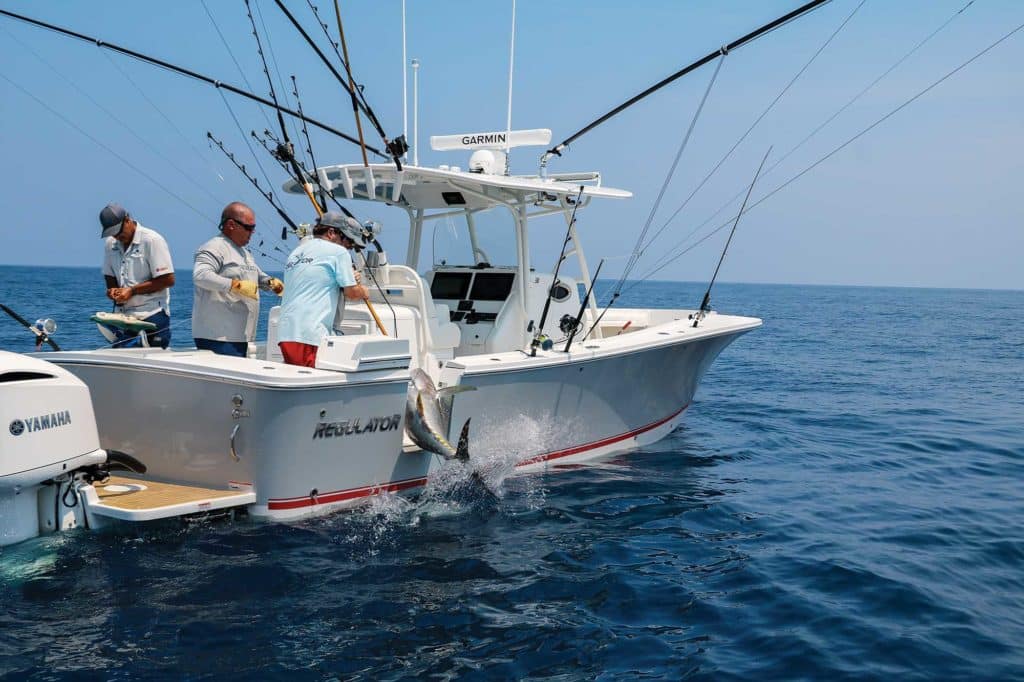
“One of the best places to stow rods is along the sides of the center console itself,” SeaVee’s Caballero says. “This keeps them out of the way yet convenient to access.” To maximize the number of vertical rod holders along the console, SeaVee uses a front-entry to the console interior (as opposed to a side door) and equips many boats with Key West-style tops that narrow forward of the helm to allow for taller rods.
Rocket launchers in the rigging station aft of the leaning post are another option. Angled slightly aft, these rod holders are also convenient to access, but stowed rods can interfere with backcasts for anglers fishing in the aft cockpit. Rod holders on the aft edge of a T-top or hardtop are less likely to interfere with casting, but you often need to stand on a seat or gunwale to stow or retrieve a rod and reel.
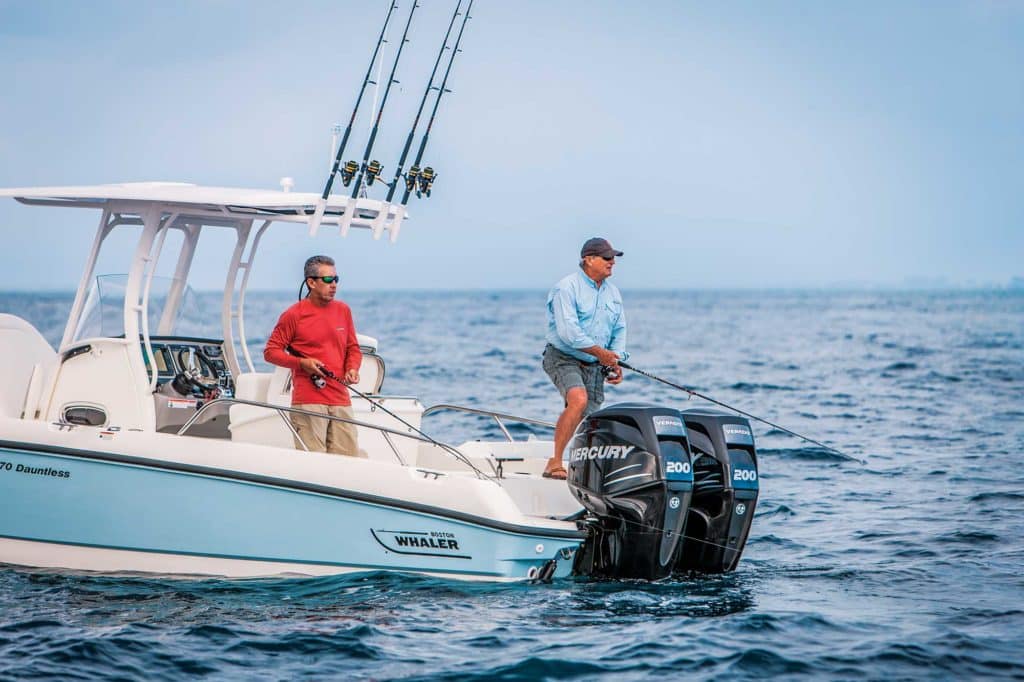
Most new offshore center-console fishing boats have full transoms separating the aft cockpit from the integral outboard bracket and splashwell. This provides a place to add easy-to-access vertical rod holders. Nicknamed “shotgun” rod holders, they are ideal for stowage or for adding a centerline to the spread. Surprisingly, 43 percent of survey respondents said they need lockable rod stowage on their boats, but most boats have some. Boston Whaler’s 350 Outrage, for example, features lockable stowage for up to six rod-and-reel outfits under the forward console lounge. Larger center-console boats often have dedicated rod stowage inside the console itself. Scout’s 380 LXF, for instance, has a vertical rack for five rods inside the locking cabinlike console interior.
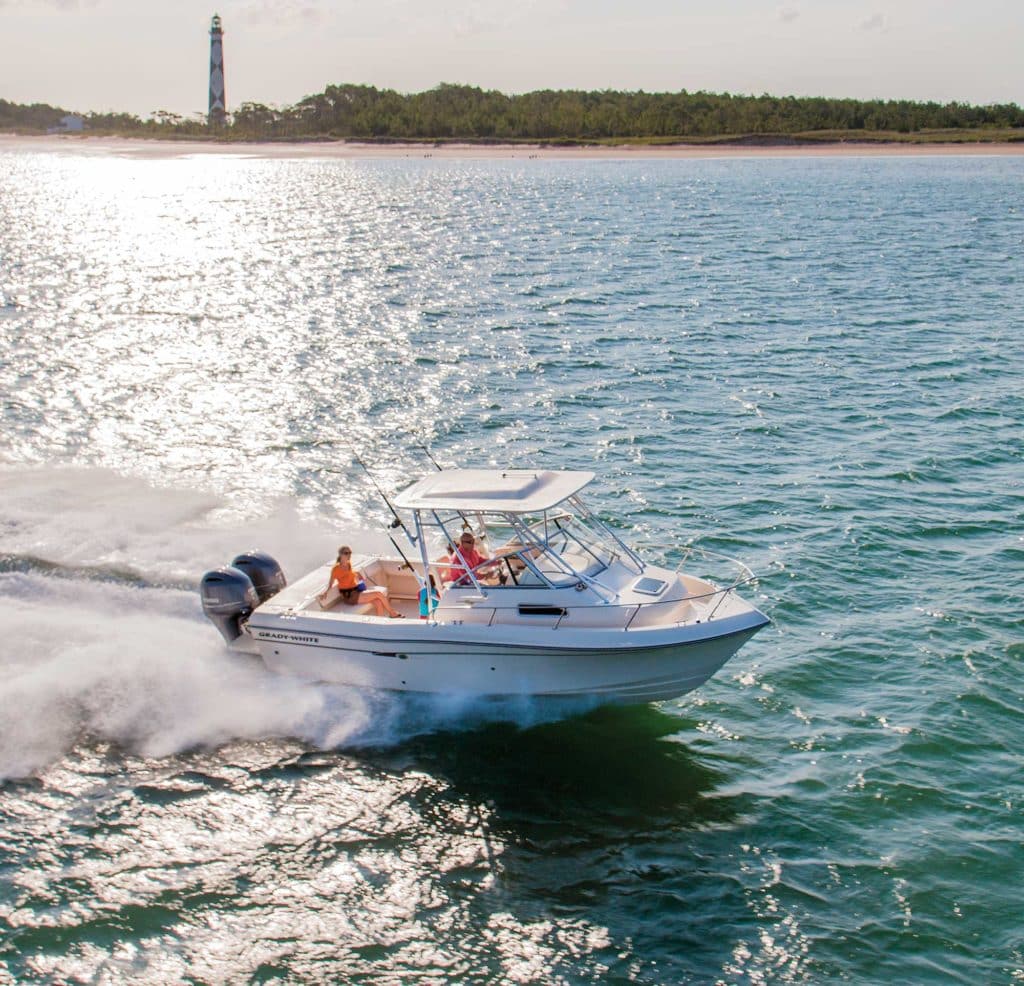
Walkarounds
By Sam White
Walkaround designs combine the fishability of a center-console with the amenities of a forward cabin, and are especially versatile boats for those who enjoy fishing and cruising, with the occasional overnight trip thrown in for good measure. The walkaround design enables anglers or crewmembers to easily access the bow area, whether for fighting a large game fish around the boat or anchoring up on a wreck or reef. A full windshield or similar enclosure provides good protection from the elements.
Accommodations
Walkarounds offer more in the way of creature comforts than center-consoles. Grady-White is a mainstay of the category, building very popular walkaround- and express-cabin designs from 20 to 37 feet. Each model shares a few important similarities, including an enclosed head for privacy, plus sleeping arrangements for at least two people. Another popular walkaround, the Boston Whaler 345 Conquest, offers the Dynamic Cabin System — a forward-berth dining table that seats six adults and converts into a queen-size bed with the push of a button. Several of our survey respondents said their favorite feature of a walkaround-style boat was the ability to get out of the weather, a definite plus for this design.

Fishability
With their relatively large cockpits, walkaround boats are outstanding for all kinds of fishing, from offshore trolling and live-baiting to wreck and bottomfishing. Most brands will feature plenty of built-in tackle storage, eliminating the need to bring additional gear with you each morning. Livewells are another important consideration, depending on the style of fishing—69 percent of those surveyed said that one livewell was sufficient for their style of fishing. When not in use, livewells can also be used for additional storage for items such as fenders and dock lines.
Performance
Outboards in single, twin or triple configurations provide impressive performance, notably in the Intrepid 375 Walkaround, which has a twin-stepped-hull design and a hardcore offshore pedigree. Combine outboard propulsion with one of the new joystick piloting packages, and dockside maneuverability is greatly improved as well. Even novices will have no problem negotiating a busy fuel dock.
When asked for the reasons why they fish, 80 percent of our survey’s respondents said it was to enjoy nature and the outdoors, with 79 percent saying it was for the fun and recreation. Few boats on the water can meet those needs more than a well-built walkaround.
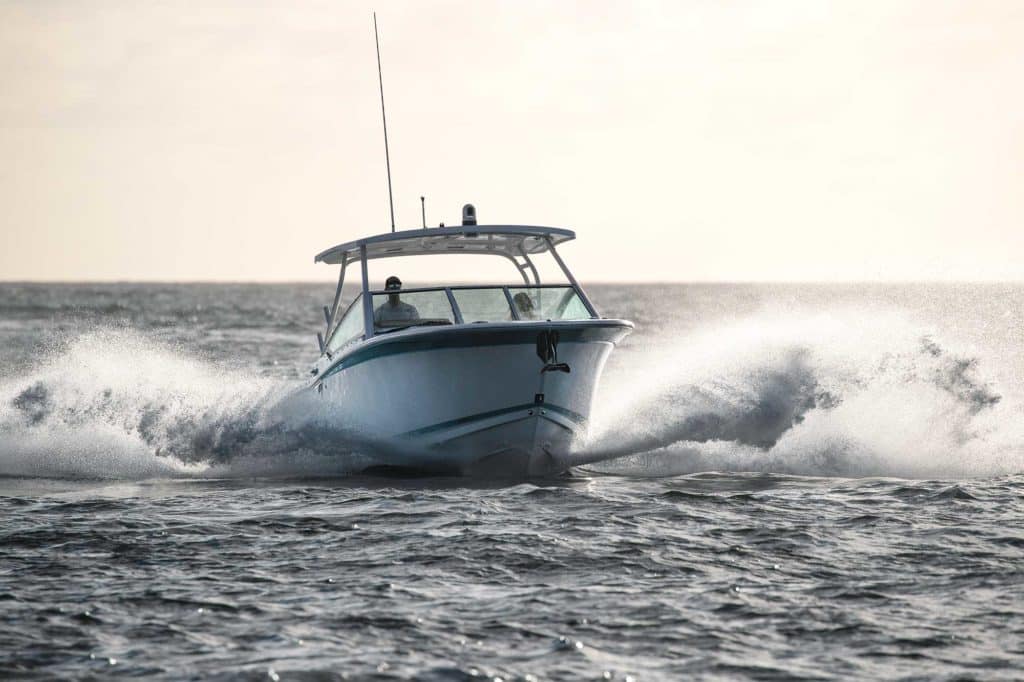
Dual-Consoles
By Sam White
A dual-console boat is laid out just as the name implies, with the helm forward and usually offset to starboard, and a second console to port. A walk-through arrangement in the windshield allows passengers to access the bow area, with plenty of additional wraparound seating or lounging room. This style of boat is usually considered a multipurpose runabout that is just as capable of pulling a wakeboarder or cruising as it is fishing. However, the new breed of dual-console designs from brands such as Cobia, Everglades, Grady-White, Scout and others has greatly expanded the fishing side, making them capable performers.
Layout
The dual-console’s cockpit is quite similar to that of a walkaround. Without the need to work around a large console and leaning post on the centerline, anglers can comfortably troll or bottomfish with ease. Nearly all of these models feature aft seating that flips down to accommodate passengers but that can also be quickly stowed out of the way when the fishing action turns on. A full windshield gives this design good protection from the elements. And since everyone stays inside the boat, even when moving forward to the bow, there is much less chance for small children to find their way overboard from inadvertently slipping on a slick gunwale. The larger models also offer enclosed heads for privacy, plus numerous other family-friendly amenities.
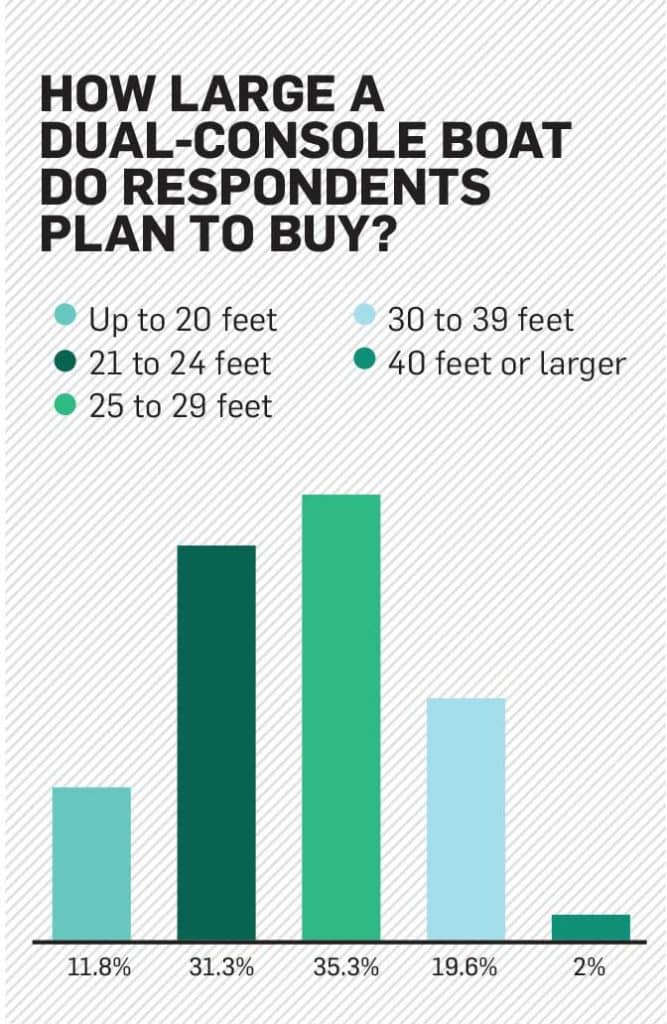
Fishability
Livewells, tackle storage and other fishing-friendly features are also finding their way into these sport-utility boats. For example, Boston Whaler’s Vantage dual-consoles have an optional fishing package that includes a lighted 19-gallon livewell, transom-mounted rod holders, and a raw-water washdown that’s perfect for keeping the decks clean in between bites. The Scout 275 Dorado — the largest in its dual-console fleet — has a layout that includes port and starboard fish boxes in the deck. With its built-in tackle storage, a 25-gallon aft livewell, both raw-water and freshwater washdowns, and plenty of rod storage, it’s also a capable performer. Grady-White has been building dual-console boats since 1979, and currently has nine different models in its lineup, as large as 37 feet. They include many standard and optional features inherent to the brand, including large in-deck fish boxes, lighted livewells and plenty of rod storage. Fold up the seating, and the cockpit becomes a supremely workable space for casting, trolling or bottomfishing.
And while few dual-consoles will be found on the distant offshore-fishing grounds, these designs perfectly fill the family-fishing niche. With 73 percent of our survey’s respondents saying they fish primarily in inshore waters, and 72 percent targeting the nearshore and coastal regions, a dual-console is a near-perfect fit for family fun.
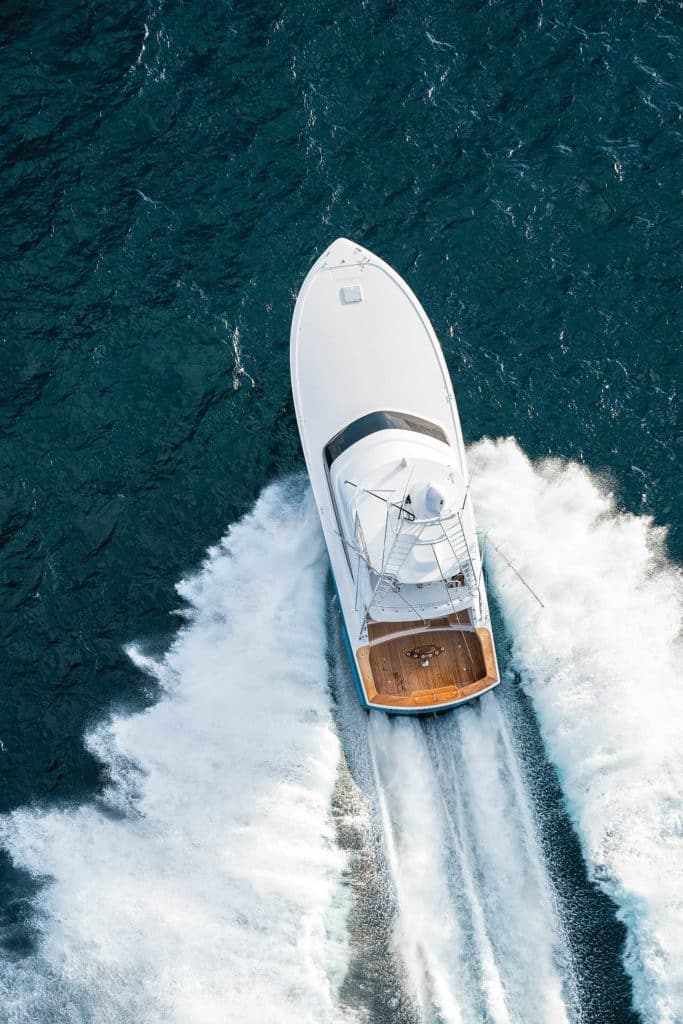
Inboards
By Sam White
For serious offshore duty, it’s hard to beat an inboard-powered sport-fisherman. With a pair of heavy-duty diesel engines thrumming away belowdecks, these boats are unmatched for reliability, long range and overall comfort, either in convertible or express design configurations.
A primary consideration for inboard-powered boats is whether to choose a production or custom boat. Production boats such as those from Viking, Bertram, Hatteras, Cabo, and others generally have an excellent brand reputation and are constructed of highly durable fiberglass using a series of molds. Custom boats, on the other hand, are individually built to the owner’s specifications, some using fiberglass-over-wood cold-molded construction techniques. Both styles also may incorporate lightweight composite cores or even exotic materials such as carbon fiber in their construction.

Fishability
With spacious cockpits, these are unparalleled fishing machines, able to incorporate full-size fighting chairs in the largest boats and rocket launchers in even the smallest of inboards. They generally have larger outriggers, able to spread the lines across a wide swath of oceanic real estate, and most will have large fish boxes in either the transom or deck for the catch of the day. And with their inboard engines set far apart and swinging proportionately large propellers, these boats can spin and maneuver on a dime, matching even the swiftest marlin or game fish move for move. Among the attributes most favored by our survey respondents, ease of operation with single-lever controls ranked high, as did the easy access to electronics.
Accommodations
With room for a full-size generator, most inboard boats will feel like home, with air conditioning, a spacious galley with cooktop and/or microwave oven, and even high-definition home-theater televisions and sound systems. And while they can also be found on smaller center-consoles, large sport-fishers are more often equipped with a Seakeeper gyrostabilizer, further adding to the already high comfort level. For chasing offshore game fish, it’s hard to beat the amenities and fishability of an inboard-powered sport-fisher.




